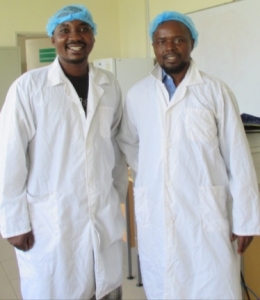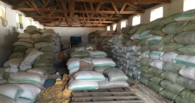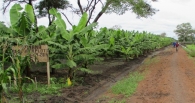G8 New Alliance for Food Security and Nutrition
An article by the New Alliance Country Facilitator
Hannock Kumwenda
11 May 2015
/
- 0 Comments

The Country Facilitator is with an engineer at a fruit processing factory: one has to be 100 percent sanitary to walk inside such a factory. Guess who is the facilitator in the picture? (Hannock Kumwenda)
Whenever I introduce myself in the name of my job these days, I dread the question that follows almost instinctively: ‘what is the New Alliance for Food Security and Nutrition?’ It is always a 5- minute-plus conversation to give an answer. So I have developed a survival strategy when introducing myself outside the circles of the New Alliance: I simply say that I am a consultant and rarely do I get instinctive follow-up questions!
We start off at Camp David, May 2012, where G8 and African leaders commit to the next phase (hence New Alliance!) of their shared commitment to achieving global food security. There they agree on three things: increase responsible domestic and foreign private investment into African agri
culture; take innovations that can enhance agricultural productivity to scale; and reduce the risk borne by vulnerable communities. There it is: the New Alliance for Food Security and Nutrition is born with a shared commitment to achieve sustained and inclusive agricultural growth with the goal of raising 50 million people out of poverty over the next ten years in Africa. I am not here to figure out how they arrived at that number – you can be sure though that someone had a calculator at that Camp David summit!
Here am I finding myself working as a New Alliance Country Facilitator (thanks to Mokoro and the AESA Consortium) for my own country Malawi, which was the eighth country to join the New Alliance. She joined in 2013 and I myself started work a year later in October 2014. As of to date, there are 11 countries in the New Alliance and more countries are expected to join in the coming years. It is a voluntary choice by any African government to join. I am now into the sixth month of my job and in a much better position to tell you something about the business of the New Alliance and how it discharges it in my small beautiful country – a country that has hills and mountains and valleys, rivers and forests, and a big fresh water lake cannot be anything but beautiful!
My small country has a knack for seizing opportunities linked to foreign assistance and I am not surprised that she is among the first few countries in the New Alliance. I wish she was just as good at reducing poverty! My country, through the New Alliance Initiative, has planned to graduate 2 million people out of poverty come 2022. From the look of things, this may not be an impossible target to achieve. The country has an estimated population of around 15 million and about half of them live below the poverty line. So the target we have set to achieve over the ten-year period under consideration does not look over-ambitious as such.
The New Alliance has mobilised a group of energetic stakeholders in government, donor community, private sector and civil society to come together and create a conducive environment for doing business with fair market returns for smallholders; increase access to water and basic infrastructure; improve productivity, storage of produce and its packaging; and increase the uptake of nutritive foods and diets so as to reduce malnutrition disorders. They have a country cooperation framework (CCF) to guide their partnership engagements, and the CCF is aligned to priorities of the country’s agriculture investment plan. This includes funding commitments by donors, specific policy actions by government, and statements of investment intentions from the private sector. The New Alliance develops no policies or activities of its own other than those that have already been identified in the country’s policies and development strategies, and has no money or resources of its own: each stakeholder keeps their resources and allocates them based on the evolving needs of the partnership. This is the essence of the new way of doing business… Surely this is a strange group of stakeholders to bring together for a common cause. How does government see eye to eye with the private sector and civil society, and vice versa? How does the civil society work with its perennial foes, government and the private sector? And can our good donors succeed in aligning their support to the country’s stated priorities only? The New Alliance has determined to overcome divisive weaknesses of its members for a common cause here and, in my country, so far so good…
There are eight government Ministries, nine donor partners, 21 private sector companies and three civil society organisations working together to improve private investment by addressing investment hurdles in about nine areas; key among them are markets, land, cost of finance, and taxation. These parties have established a country cooperation framework outlining all key areas and attendant policies that they will be working on to implement. At the moment, it is safe to say that the agreed priority issues have broad consensus. The implementation will, I sincerely anticipate, reveal true allegiances, though. For the New Alliance is very much like new wine that demands new wineskins to succeed but there is a shortage of new wineskins… In the past, the bureaucrat would make his policies on the desk and wait for private sector response: the New Alliance is demanding the opposite!
Let me share with you some reasons for keeping our fingers crossed here. We have issues of land to sort out: the private sector wants to access thousands of hectares of land for green field agricultural investments. In my country, and that applies to many other African countries, all land starts out as customary land in the hands of community leaders, so there is no free land, i.e. land that has no owner. From customary, through many winding processes, it becomes private or public (government). Currently, government has hardly land of its own to satisfy private sector needs and so obviously customary land has to be called upon, especially where the investment is targeting rural areas. This is why the New Alliance (in some African countries where it started earlier) is being accused of land grabbing because it is not possible to acquire customary land without displacement. Even with adequate compensation, the New Alliance will still stand accused of grabbing land from the poor smallholder farmer by some very creative vigilante!
Or let us take a look at taxation: any tax waiver or better management of tax complaints can mean losing revenue to government. Yet our government has been running an austerity budget for the last four years or so, with, in my calculation, no end in sight in the short term. How will government react to requests for more tax waivers or better tax administration? It will not be easy to make progress here…
I hope you can see that the first six months of my job may be the better part; the next twelve months require gloves and a thick skin! We have to face reality, but fortunately I will not be alone. All other stakeholders in the New Alliance will be in the same mokoro (i.e. boat). I do not foresee the New Alliance collapsing, mainly because the most contentious and sensitive issues do not seem to affect everyone equally. As of to date, we have already seen two of the 21 private sector companies complete their new investment intentions and this is a good sign. However, it is those quantitative targets – 2 million people, 50 million people, etc. – that I have my doubts about…
I think that this is one of the most innovative initiatives that my country has signed and I will dedicate my time to see it work and get it through difficult times that may come ahead. I believe that a vibrant private sector with strong market linkages to smallholder farmers is the most sustainable development trajectory for my country. We also have many unemployed youths from schools and colleges that can find jobs if we can develop new labour-intensive investment opportunities. Perhaps more attractive for me are the local economy forward and backward linkages in commercial opportunities being generated through the New Alliance as some of the agro-manufacturing companies depend entirely on the smallholders, with a heavy presence of our womenfolk, for the supply of raw materials. I cannot see any model better than or competing with the New Alliance in terms of delivering inclusive and equitable economic growth. All this is dependent on country-specific arrangements for implementation and I would not be surprised to hear that it is not working well elsewhere.
You must be logged in to post a comment.



